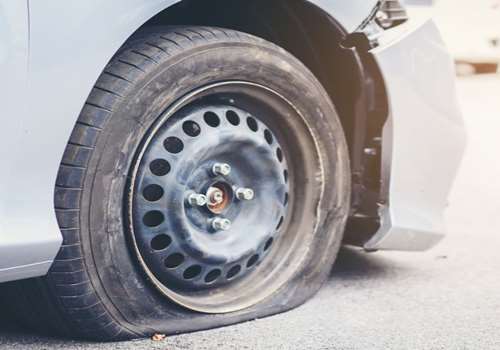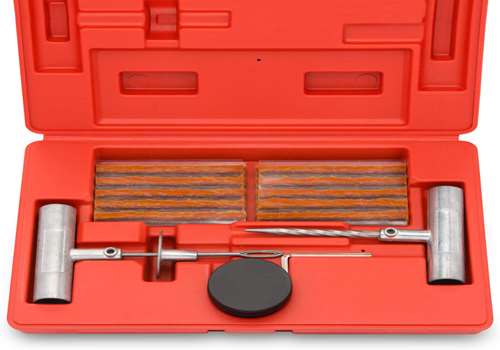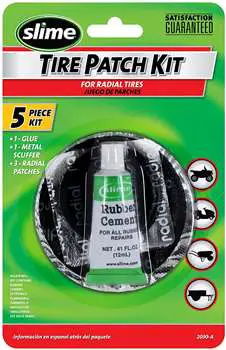
What is a Tire Plug?
To make it simple, a tire plug is a sticky rubber object that is used to fix any rupture in the tire’s outer surface. A tire plug looks like a rubber rope around 4 inches in length which is why it is also known as a rope plug.
It’s one of the cheapest and most effective ways to fix a flat tire as tire plugs are made of a butyl rubber compound. They work perfectly for punctures caused by nails or other sharp objects.
You do not have to remove the tire which makes the job quite easy and super quick. Without much hassle, you can easily fix a maximum of half-inch hole in the tire.
Nonetheless, a tire plug will be of no use if the puncture occurs at the sidewall or the rim area as those areas are hard to reach hence, the puncture would not be completely sealed.
What is a Tire Patch?
Another great way to fix a punctured tire? Surely, but what is even better? It is far more reliable and lasting than a plug.
The first thing you’d notice is that it is hard to patch a tire as for this you need to get off a tire and remove the rim; then a rubber patch is glued on the inner side of the tire.
The patch vulcanizes as soon as the temperature of the tire goes up. Take your car for a ride and your patch is all done.
A simple yet very handy tell-a-part of a plug and a patch is that the latter fixes bigger, more irregular ruptures on almost any part of the tire which a plug can’t.
What is the Difference Between a Tire Plug and a Tire Patch?
Are you the kind of driver who is facing tire problems now and again and your daily terrain for driving is pretty rough so you can’t do much about it?
Tire plug and patch are pretty much close to life-saving when it comes to situations like these. Get a flat tire and need a quick solution, it is your go-to.
Tire plug and tire patch serve a somewhat similar purpose i.e. fixing a punctured tire. The main difference between them is that plug is used for small holes that are less than a half-inch while the patch can repair the big and irregular shape puncture easily. However, if you are wondering how they are different from each other, keep on reading to find out.
Why should use a Tire Plug vs Patch
Puncture Size and Shape: Tire plugs are best suited for small and regular shaped holes made by a nail or something like that, while a patch is best for big damaged.
Puncture Location: if the puncture is in the center of the tire, the plug works great because tire rotation vulcanizes the plug, but on the sidewall of the tires patch won the match.
Ease of Repairing: Patch need effort to repair a tire because you have to remove the tire rim and then apply the patch, but on the other hand tire plug is just like a plug and drive.
Cost: Tire plugs cost is less than the cost of the patch because it required a handyman.
Cost of Tire Plug vs Tire Patch
What Does it Cost to Plug a Tire?
Let’s talk about prices, the most important part of a purchase. Before you get one know what it is useful for.
A tire plug works great to fix a hole caused by a nail (around half an inch) around the central area of the tire using a tire plug kit.
If you are from the States, it’ll cost about $5-$15 to repair a punctured tire using a tire plug and a kit. See! Not-so-expensive and super effective, all at the same time.
What Does a Tire Patch Cost?
A tire patch is far more effective and long-lasting than a plug which means it will cost a bit more as well but don’t worry as its totally a value-for-money deal.
For a puncture bigger than a half-inch or any sidewall tire damage, a plug won’t work that well. A patch is what will not only fix the problem but avoid future damage too.
It’ll cost you around $30-$40 for a patch for sidewall tire repair. The reason for a rise in the price is that the procedure of patching a tire requires the removal of the tire and glue which secures the patch in the place.
But hang on a minute
Do Tire Plugs Last?
Is a tire plug permanent? The longevity of a tire plug depends entirely on how it was installed. It tends to last more if a plug is installed using a proper kit and vulcanize it correctly. If a rubber cement is used to seal it, it will ensure that you do not need to replace it any time soon.
Tire Plug vs Patch Repair Kit Recommendation
Now that you know what is a plug and a patch are and how each stands out in its category, let’s move on to each’s kit. A kit is essential and makes the maneuver much smoother.
Plug Kit
Talking about the best tire plug repair kit in the market, the Tooluxe Universal Repair Kit works great. If you are considering buying a tire plug kit, check out the points below. Check out the latest price details of the kit.
- You can easily fix punctures from all tumble’s tires and wait for the best part… you don’t even have to remove the rim!
- You will experience minimum wrist strain as the T-design offers a wider turning point.
- It is a one-time expense as the durability will ensure the kit goes a long way.
- There will be no storage problems for your case it comes in a case that is perfect for roadside emergencies.
- What’s in the box? 1-pc rasp tool, 30-pc 4” string plugs for multiple repairs, 1-pc insert tool, 1 sealing lubricant, and 2-pc hex keys.
Patch Kit
A punctured tire is a common problem for people who are almost all the time on the road. A tire patch kit is a great way to not only fix your flat tire but permanently get rid of this problem.
Don’t sweat too much when it comes to things like this; if you are looking forward to buy a tire patch kit, Slime 2030-A Tire Patch Kit is a perfect choice, and here is why. Check out the latest price details of the kit.
- This kit works for almost any vehicle; bicycles, mowers, ATVs, and wheelbarrows
- Each kit includes 5 pieces to cover all your punctured tire holes. The included patches are rubber cement, radial patches, and a metal scuffer.
- You can fix all sorts of ruptures in the small tubeless tires effortlessly.
Now, its Time for You to learn
How to Plug a Tire?
Having a tire plug kit is the foremost essential part and I can stress this enough. It will not only make the job easier but you will be able to fix a puncture anywhere, anytime. Things you need are:
- Plug tire kit
- A tire plug (of course)
- A reamer
- A plug-insert
- Rubber cement
Procedure
Take a plug-in insert tool and insert a plug through its hole. You’d notice it’s pretty sticky which will only help to make the process more reliable. If you find it hard to feed it, use pliers.
Pull out the nail or whatever punctured the tire. Use a ring reamer to clean and broaden the hole for the plug to fit in properly.
Now, take the rubber cement and coat the plug and insert it in the hole using the plug-insert. Remember you will need to apply some pressure here to make it work. Trim off any excess plug.
How to Patch a Tire?
Before getting into patching your tire, you need to remove the tire’s rim and locate the puncturing agent which can be a nail, etc.
Next up, buff the inner surface of the tire to get an even canvas to work. Clean the freshly buffed area and make sure it is dry. Apply some rubber cement and let it dry.
Now for the fun part, applying the patch. The radial patch always works great. Put on some repair sealant on the patched surface for extra protection. Et Voila!
Is it Better to Patch or Plug a Tire?
So, which is better tire plug or patch? Let’s talk about the real deal. When it comes to a tire plug and a patch, both have their cons and pros.
What you need depends entirely on the nature and intensity of the damage. If you got a small slit, a plug would do just fine but you be needing a patch for a bigger hole.
If you ask me, a patch is always a better option, more reliable, and more durable. It is not quite visible and does not damage the threads of the tire in any way.
The best thing about a patch is that it can fix punctures of any nature in any place on the tire whereas plugs have their limitations.
Curious about
Are Tire Plugs Legal?
Let’s talk about legal stuff. You can generally buy a plug from any tire repair shop around the USA. This means that tire plugs are legal all over the USA.
There is no federal law like the T.R.E.A.D. (Transportation Recall Enhancement, Accountability, and Documentation) that goes against using plug tire to fix holes in tires.
Is it Safe to Patch a Motorcycle Tire?
This question is literally everywhere on the internet. People answer this based on their opinion and experience which might be reliable or not.
Mostly, in the USA, you won’t be able to get a patch on your bike’s tire as dealerships and repair shops avoid doing so because of the liability that will come and bite them in the ‘posterior’ later.
The problem if the patch-fixing fails, the crash can be lethal and people sue the dealerships which cost them more than the money they made patching the motorcycle tire.
Some say that despite plugging a tire, replace it as soon as possible. Or better yet, plug the rear and drive the bike into cords before replacing the front tire.
A large part of people thinks that a plugged tire in motorcycle work just fine. All you need to do is to inspect it often and immediately replace it in case of a problem.
Here is a piece of quick advice, be very careful while plugging the tire, keep an eye on its condition, and replace the front tire promptly. Don’t forget to run the read down to the cords.
If the plugged tire does not retain air for long, get rid of its ASAP.
Always remember that every puncture is different in nature and size. A plugging kit will help you get home with a punctured tire so you can individually and thoroughly examine each hole.


